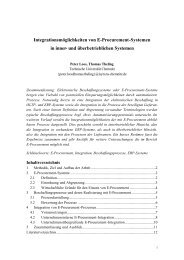Hedonic and Utilitarian Motivations of Social Network Site Adoption
Hedonic and Utilitarian Motivations of Social Network Site Adoption
Hedonic and Utilitarian Motivations of Social Network Site Adoption
Create successful ePaper yourself
Turn your PDF publications into a flip-book with our unique Google optimized e-Paper software.
argumentation, both constructs can be expected to have an impact on the Behavioral Intention to<br />
Use SNSs. We hypothesize that:<br />
H1: There is a positive relationship between the Perceived Usefulness <strong>of</strong> a <strong>Social</strong> <strong>Network</strong> <strong>Site</strong> <strong>and</strong><br />
the Behavioral Intention to Use it.<br />
H2: There is a positive relationship between the Perceived Enjoyment <strong>of</strong> a <strong>Social</strong> <strong>Network</strong> <strong>Site</strong> <strong>and</strong><br />
the Behavioral Intention to Use it.<br />
Figure 2.<br />
Research model.<br />
Further, Perceived Enjoyment has been confirmed multiple times to have a positive influence on<br />
Perceived Usefulness (e.g., Venkatesh et al., 2002; Sun <strong>and</strong> Zhang, 2006). The rationale behind this<br />
is that intrinsic motivations amplify people’s perceptions <strong>of</strong> extrinsic motivations (Batra <strong>and</strong> Ray,<br />
1986) <strong>and</strong> increase the deliberation <strong>and</strong> thoroughness <strong>of</strong> cognitive processing (Bagozzi et al., 1999).<br />
Hence, we hypothesize that:<br />
H3: There is a positive relationship between the Perceived Enjoyment <strong>of</strong> a <strong>Social</strong> <strong>Network</strong> <strong>Site</strong> <strong>and</strong><br />
its Perceived Usefulness.<br />
Additionally, in line with the initial TAM <strong>and</strong> its multiple extensions/modifications, the Perceived<br />
Ease <strong>of</strong> Use <strong>of</strong> an information technology is commonly accepted to be an important antecedent <strong>of</strong><br />
Behavioral Intention to Use <strong>and</strong> Perceived Usefulness (e.g., Venkatesh <strong>and</strong> Davis, 2000; Venkatesh<br />
<strong>and</strong> Bala, 2008). Also, multiple studies confirm that Perceived Ease <strong>of</strong> Use has a significant<br />
positive influence on Perceived Enjoyment (e.g., Davis et al., 1992; Moon <strong>and</strong> Kim, 2001; Van der<br />
Heijden, 2004; Chesney, 2006). The most common explanation for this is that an easy-to-use system<br />
saves time for the user, thus allowing him/her to spend additional time enjoying the experience <strong>of</strong> it<br />
(Van der Heijden, 2004; Hu et al., 2011). Hence, we hypothesize that:<br />
H4: There is a positive relationship between the Perceived Ease <strong>of</strong> Use <strong>of</strong> a <strong>Social</strong> <strong>Network</strong> <strong>Site</strong><br />
<strong>and</strong> the Behavioral Intention to Use it.<br />
H5: There is a positive relationship between Perceived Ease <strong>of</strong> Use <strong>of</strong> a <strong>Social</strong> <strong>Network</strong> <strong>Site</strong> <strong>and</strong> its<br />
Perceived Usefulness.<br />
H6: There is a positive relationship between the Perceived Ease <strong>of</strong> Use <strong>of</strong> a <strong>Social</strong> <strong>Network</strong> <strong>Site</strong><br />
<strong>and</strong> its Perceived Enjoyment.<br />
8







